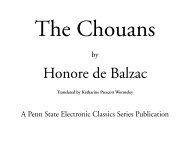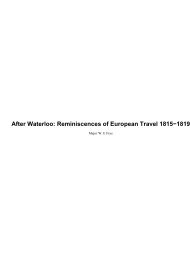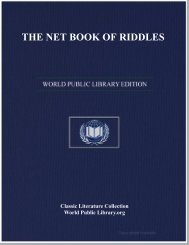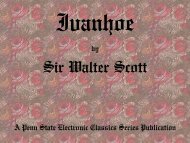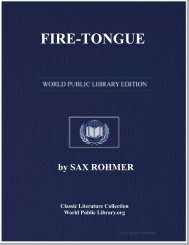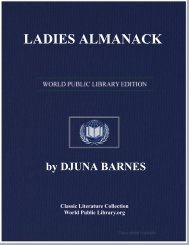THE GOD OF THE WITCHES - World eBook Library - World Public ...
THE GOD OF THE WITCHES - World eBook Library - World Public ...
THE GOD OF THE WITCHES - World eBook Library - World Public ...
Create successful ePaper yourself
Turn your PDF publications into a flip-book with our unique Google optimized e-Paper software.
Isobel Gowdie[23] volunteered the information that "the queen of Fairy is brawly clothed in white linens, and in<br />
white and brown clothes, etc., and the king of Fairy is a braw man, well favoured, and broad-faced, etc." It is<br />
most unfortunate that the recording clerk always put "etc." when Isobel began to give any real details about the<br />
fairies. Possibly he was afraid to record any information about those terrifying people.<br />
The colours of the fairies' dresses were due to dyes, produced and used like those still employed in country<br />
places. The number of indigenous plants from which dye-stuffs are obtained is surprisingly large, such plants<br />
are to be found in all parts of the British Isles and the dyes cover the whole range of colour. Lichens give very<br />
fine dyes, red, yellow and blue; besides these, other plants and trees have been in use from time immemorial<br />
and dyes are still made from their roots, bark, leaves and fruit. All combinations of colour and shade can be<br />
made by mixing the dyes, but it is perhaps worth noting that there is no record of yellow being worn by the<br />
fairies; blue, black, green, and a little red, were the chief colours. Green was the favourite colour, the reason,<br />
probably being that the fairies were originally hunters, and green made them less visible to their quarry. Later,<br />
when they themselves were hunted, green was the best colour in which to move unobserved in a forest or to lie<br />
hidden on a moor. White garments are often recorded; these were probably of linen bleached in the sun. In<br />
many stories there are accounts of the fairies spreading their linen on the grass, and the extraordinary<br />
whiteness of the material is always the subject of admiration. Isobel Gowdie in the passage quoted above,<br />
appears to have been struck with the Fairy Queen's white garments.<br />
The fairy men of lower rank wore trousers and jackets, the women skirts and bodices. The most characteristic<br />
article of attire, however, for all ranks was the hat, cap, or hood. This was so precious to a fairy that any of them<br />
would risk capture or pay any ransom to recover it if it fell into alien hands. The cap varied in shape and colour<br />
according to the district. In the West Highlands[24] the green conical caps of the fairies were like the rush<br />
helmets which children made, and like those commonly worn by Swedish Lapps. In Ireland[25] a fairy-man was<br />
"like a boy of ten or twelve years old, only more broad and bulky, dressed in a grey little coat, and stockings of<br />
the same colour, with an old little black woollen hat." In the Isle of Man" the fairies were dressed in undyed wool<br />
with little pointed red caps. In Wales[27] the male fairies had "red-tripled caps and the ladies a light fantastic<br />
headdress which waved in the wind". The fairies of Upper Brittany[28] wore a kind of cap "like a crown, which<br />
seemed to be part of their person." At Hildesheim[29] the local goblin was dressed like a peasant, but so<br />
invariably wore a hood that he was called Hedekin or Hutkin. Even so far away as Eastern Europe a Slav<br />
story[30] gives an account of a man who saw "two little demons pulling each other's hair. By the cut of their short<br />
waistcoats, by their tight pantaloons and their three-cornered hats, he knew that they were inhabitants of the<br />
nether world."<br />
Fairies of higher rank were naturally better dressed. The king and queen, when riding in procession, wore rich<br />
garments and were always crowned; on less solemn occasions they were dressed like their subjects though in<br />
richer materials. When, in a domestic emergency in the Royal Household, the Fairy Queen went herself to<br />
borrow a basinful of oatmeal from a cottage woman, she was dressed in the richest green embroidered with<br />
gold and wore a small coronet of pearls. Her servant, who returned the oatmeal, is simply recorded as being in<br />
green. This was in Kirkcudbrightshire.[31]<br />
Fairy ladies of rank wore long flowing dresses which fell to the ground in soft, sweeping folds; these robes were<br />
usually white, sometimes green, and occasionally scarlet. The hair was loose over the shoulders, which<br />
increased the beauty of the younger ladies, but the long straggling elf-locks of the older women are always<br />
commented on with horror by the "mortal" beholder. The fairy ladies covered their hair with a veil or hood, and<br />
often wore a small coronet of gold. The fairy knights wore gold or silver armour in battle or in solemn<br />
processions; for ordinary wear they dressed in green with a hat or cap; and on all occasions they wore green<br />
cloaks or mantles, possibly arranged like a plaid.<br />
When going among the villagers the records show that the fairies were dressed like their neighbours, apparently<br />
lest they should attract attention and so be recognised. Bessie Dunlop[32] (1576) did not know till long<br />
afterwards that the "stout woman" who visited her was actually the Queen of Elfhame. There are also<br />
innumerable stories of "mortals" entering a fairy knowe and thereby becoming acquainted with the appearance<br />
of some of the fairies whom they recognised later among the villagers; such recognition invariably met with<br />
20



